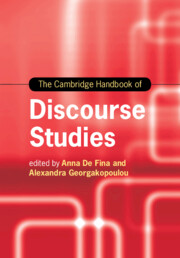Book contents
- The Cambridge Handbook of Discourse Studies
- Cambridge Handbooks in Language and Linguistics
- The Cambridge Handbook of Discourse Studies
- Copyright page
- Contents
- Figures
- Tables
- Contributors
- Preface
- Part I (Con)Textualizing Discourses
- Part II Perspectives and Modes of Analysis
- 6 Sequence Organization: Understanding What Drives Talk
- 7 Doing Micro-Analysis of Discourse: The Case of Ageing and Wellbeing
- 8 Corpus-Assisted Discourse Studies
- 9 Cognitive Linguistic and Experimental Methods in Critical Discourse Studies
- 10 Metaphor, Metonymy and Framing in Discourse
- 11 Poststructuralist Discourse Studies: From Structure to Practice
- Part III Discourse Materialities and Embodiment
- Part IV (Trans)Locations and Intersections
- Part V Ethics, Inequality and Inclusion
- Part VI Discourses, Publics and Mediatization
- Index
- References
9 - Cognitive Linguistic and Experimental Methods in Critical Discourse Studies
from Part II - Perspectives and Modes of Analysis
Published online by Cambridge University Press: 28 September 2020
- The Cambridge Handbook of Discourse Studies
- Cambridge Handbooks in Language and Linguistics
- The Cambridge Handbook of Discourse Studies
- Copyright page
- Contents
- Figures
- Tables
- Contributors
- Preface
- Part I (Con)Textualizing Discourses
- Part II Perspectives and Modes of Analysis
- 6 Sequence Organization: Understanding What Drives Talk
- 7 Doing Micro-Analysis of Discourse: The Case of Ageing and Wellbeing
- 8 Corpus-Assisted Discourse Studies
- 9 Cognitive Linguistic and Experimental Methods in Critical Discourse Studies
- 10 Metaphor, Metonymy and Framing in Discourse
- 11 Poststructuralist Discourse Studies: From Structure to Practice
- Part III Discourse Materialities and Embodiment
- Part IV (Trans)Locations and Intersections
- Part V Ethics, Inequality and Inclusion
- Part VI Discourses, Publics and Mediatization
- Index
- References
Summary
This chapter outlines an approach to critical discourse studies (CDS) based in cognitive linguistics. The approach (CL-CDS) investigates the conceptual representations associated with particular linguistic forms and considers the ideological and (de)legitimating functions that such representations may serve when cued in specific discursive contexts. A number of conceptual operations are identified as significant in this process of meaning-construction, including schematization, point of view and metaphor. Drawing on examples from various discourses, including media discourses of migration and political protest, I show how these conceptual processes are indexed in texts and consider the ideological and (de)legitimating potentials of the representations they yield, e.g. in inference, affect and attitude toward social actions. These qualitative analyses, grounded in cognitive linguistic theory, although psychologically plausible, remain empirically unverified. In this chapter, therefore, I further suggest that CDS and CL-CDS in particular can benefit from the incorporation of experimental methods as a form of triangulation. The chapter presents the methods and results from recent experimental studies in CL-CDS and discusses their implications for CDS more generally.
Keywords
- Type
- Chapter
- Information
- The Cambridge Handbook of Discourse Studies , pp. 186 - 212Publisher: Cambridge University PressPrint publication year: 2020
References
Further Reading
This book provides an introduction to corpus-assisted critical metaphor analysis with applications to a range of discursive contexts including politics, economics and religion.
This book discusses a range of discursive strategies and linguistic features from a critical cognitive linguistic perspective with example analyses of discourses of national security, war and immigration.
This book provides an introduction to cognitive linguistic critical discourse studies with chapters on structural configuration, identification, framing and positioning. A range of contemporary discourses are analyzed including discourses of riots, strikes and protest, discourses of austerity, discourses of military intervention and discourses of immigration.
This book provides an introduction to multimodality and considers, from a social semiotic perspective, the functions of different parameters, including point of view, in visual and multimodal texts.



